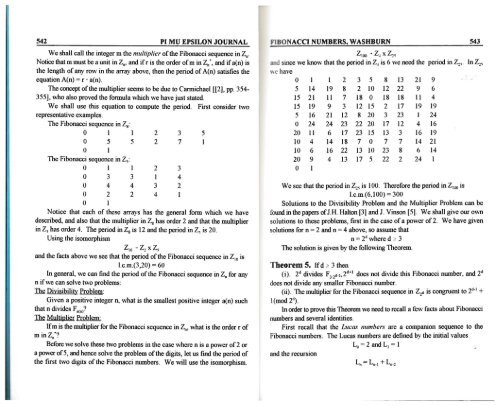Vol. 10 No 7 - Pi Mu Epsilon
Vol. 10 No 7 - Pi Mu Epsilon
Vol. 10 No 7 - Pi Mu Epsilon
Create successful ePaper yourself
Turn your PDF publications into a flip-book with our unique Google optimized e-Paper software.
542 PI MU EPSILON JOURNAL<br />
We shall call the integer m the multiplier of the Fibonacci sequence in Z 0<br />
•<br />
<strong>No</strong>tice that m must be a unit in Z 0<br />
, and if r is the order of m in Zn ·, and if a(n) is<br />
the length of any row in the array above, then the period of A(n) satisfies the<br />
equation A(n) = r · a(n).<br />
The concept of the multiplier seems to be due to Carmichael [[2], pp. 354-<br />
355], who also proved the fonnula which we have just stated.<br />
We shall use this equation to compute the period. First consider two<br />
representative examples.<br />
The Fibonacci sequence in Z 8<br />
:<br />
0 1 I 2 3 5<br />
0 5 5 2 7<br />
0<br />
The Fibonacci sequence in Z 5<br />
:<br />
0 1 1 2 3<br />
0 3 3 l 4<br />
0 4 4 3 2<br />
0 2 2 4<br />
0<br />
<strong>No</strong>tice that each of these arrays has the general form which we have<br />
described, and also that the multiplier in Z 8 has order 2 and that the multiplier<br />
in Z 5 has order 4. The period in Z 8 is 12 and the period in Z., is 20.<br />
Using the isomorphism<br />
Z <strong>10</strong><br />
-. Z 2<br />
x Z 5<br />
and the facts above we see that the period of the Fibonacci sequence in Z <strong>10</strong><br />
is<br />
l.c.m.(3,20) = 60<br />
In general, we can find the period of the Fibonacci sequence in Zn for any<br />
n if we can solve two problems:<br />
The Divisibility Problem:<br />
9iven a positive integer n. what is the smallest positive integer a(n) such<br />
that n divides F a<br />
The <strong>Mu</strong>ltiplier Problem·<br />
If m is the multiplier for the Fibonacci sequence in Zn, what is the order r of<br />
min zn•<br />
Before \Ve solve these two problems in the case where n is a power of 2 or<br />
a power of5, and hence solve the problem of the digits, let us find the period of<br />
the first two digits of the Fibonacci numbers. We will use the isomorphism.<br />
n BONACCI NUMBERS, WASHBURN<br />
Z <strong>10</strong>0 ... z~ x Z 2 'i<br />
and since we know that the period in Z 4 is 6 \Ve need the period in Z::'i·<br />
\\C have<br />
0 1 2 3 5 8 13 21 9<br />
5 14 19 8 2 <strong>10</strong> 12 22 9 6<br />
15 21 11 7 18 0 18 18 11 4<br />
15 19 9 3 12 15 2 17 19 19<br />
5 16 21 12 8 20 3 23 24<br />
0 24 24 23 22 20 17 12 4 16<br />
20 11 6 17 23 15 13 3 16 19<br />
<strong>10</strong> 4 14 18 7 () 7 7 14 21<br />
<strong>10</strong> 6 16 22 l3 <strong>10</strong> 23 8 6 14<br />
20 9 4 13 17 5 22 2 24<br />
0 I<br />
We see that the period in Z 25<br />
is <strong>10</strong>0. Therefore the period in Z <strong>10</strong>0 is<br />
l.c.m.(6JOO) = 300<br />
Solutions to the Divisibility Problem and the <strong>Mu</strong>ltiplier Problem can be<br />
found in the papers of J.H. Halton (3] and J. Vinson [ 5]. We shall give our O\\on<br />
solutions to these problems, first in the case of a power of 2. We have given<br />
solutions for n = 2 and n = 4 above, so asswne that<br />
n = 2d where d ' 3<br />
The solution is given by the following Theorem.<br />
Theorem S. If d 3 then<br />
(i). 2d divides FHd-2,2d+I does not divide this Fibonacci number, and 2d<br />
does not divide any smaller Fibonacci number.<br />
(ii). The multiplier for the Fibonacci sequence in Z d 2<br />
is congruent to 2d-t +<br />
l(mod 2d).<br />
In order to prove this Theorem we need to recall a few facts about Fibonacci<br />
numbers and several identities.<br />
First recall that the Lucas numbers are a companion sequence to the<br />
Fibonacci numbers. The Lucas numbers are defined by the initial values<br />
L 0<br />
= 2 and L 1 = 1 ·..<br />
and the recursion<br />
543
















